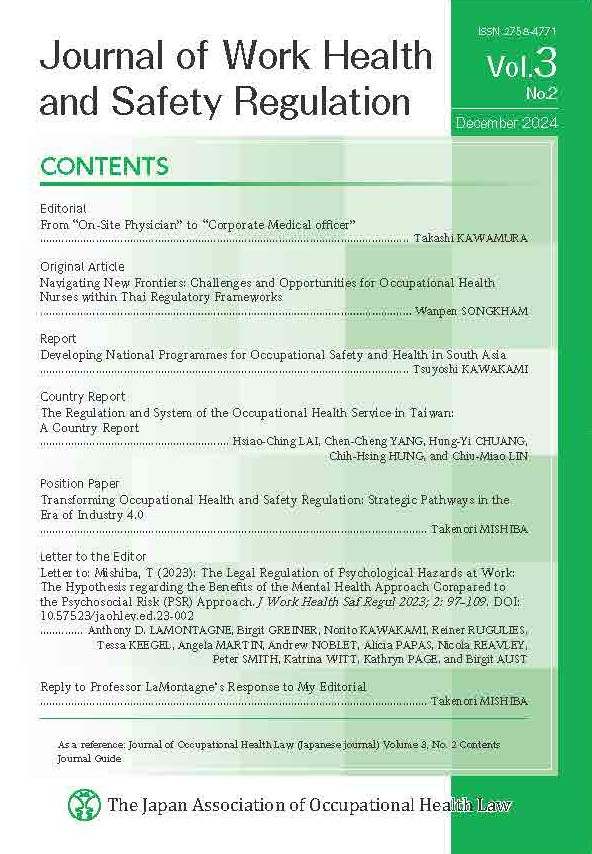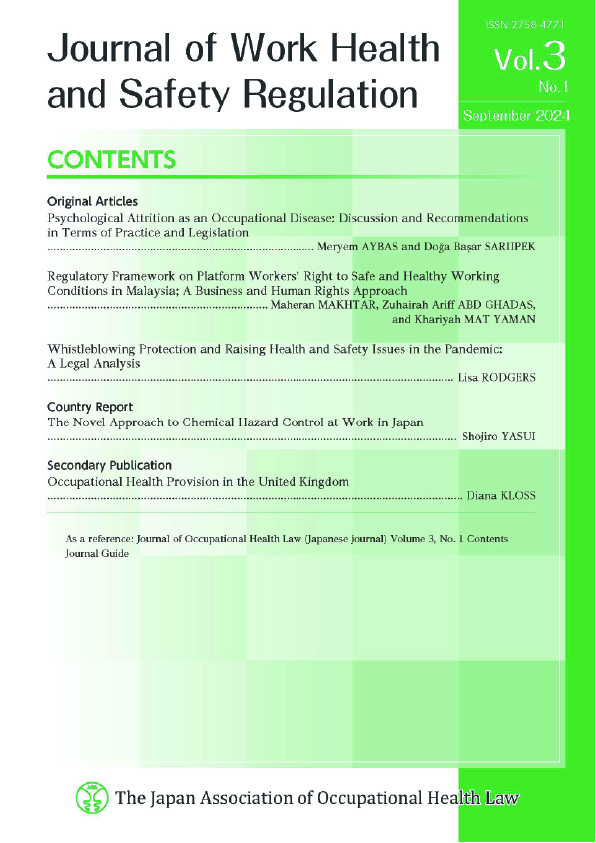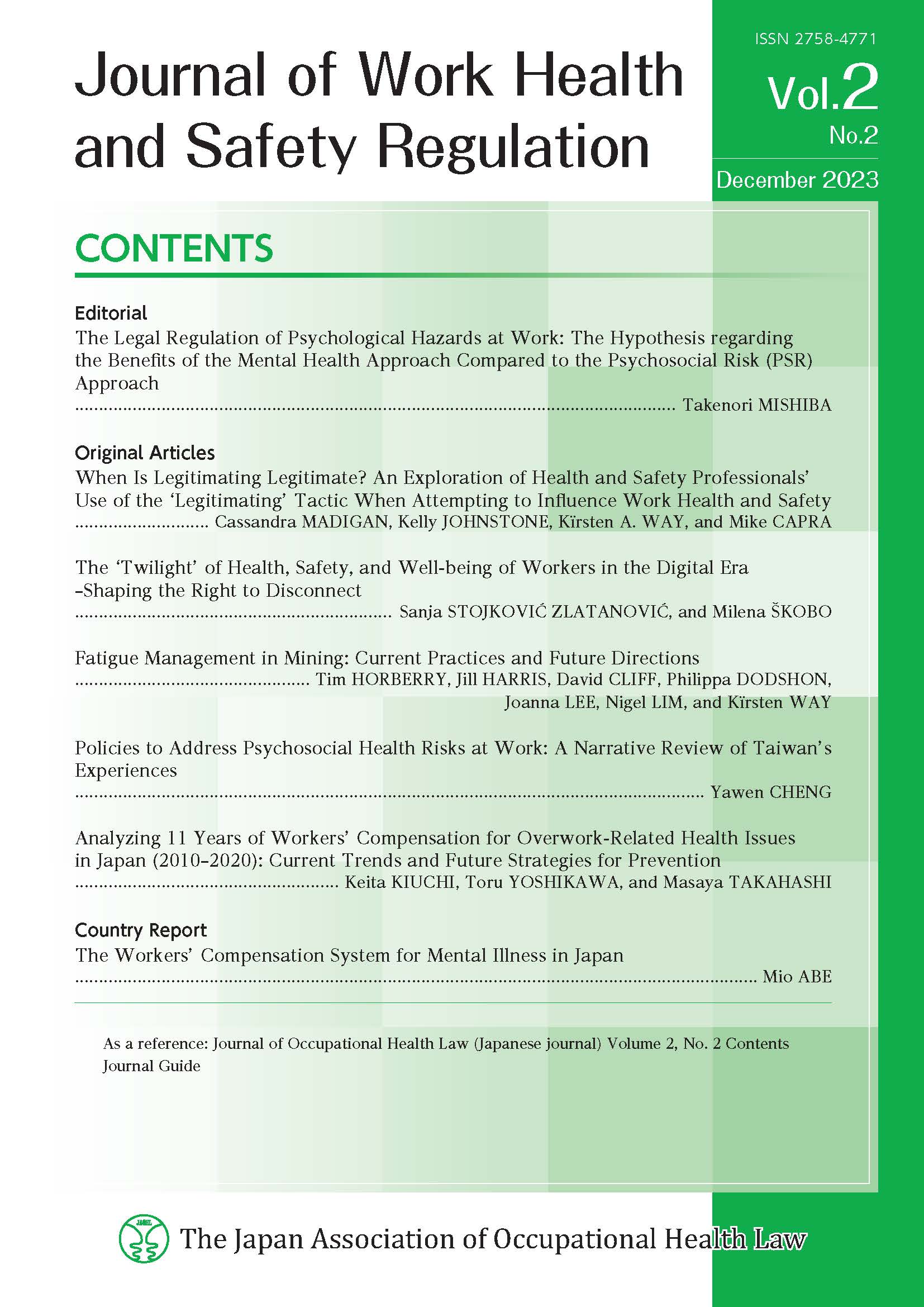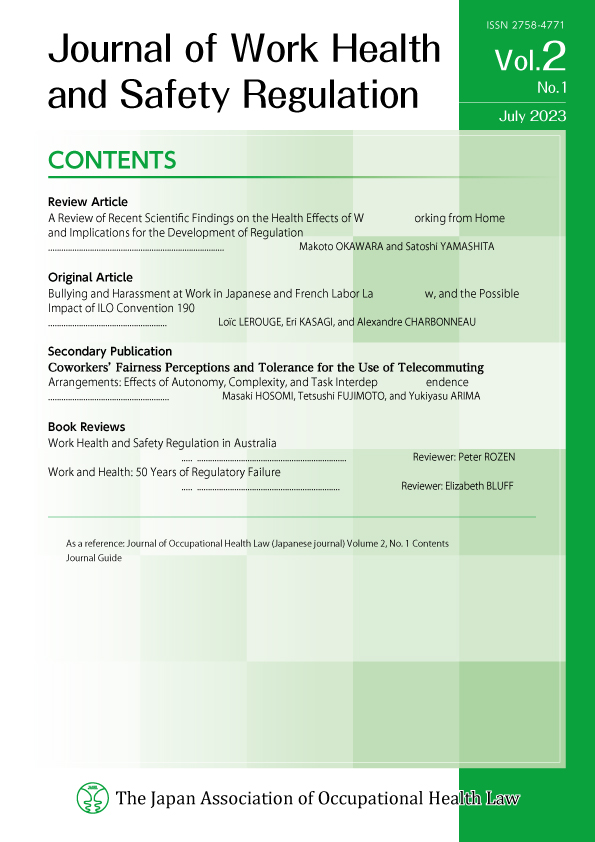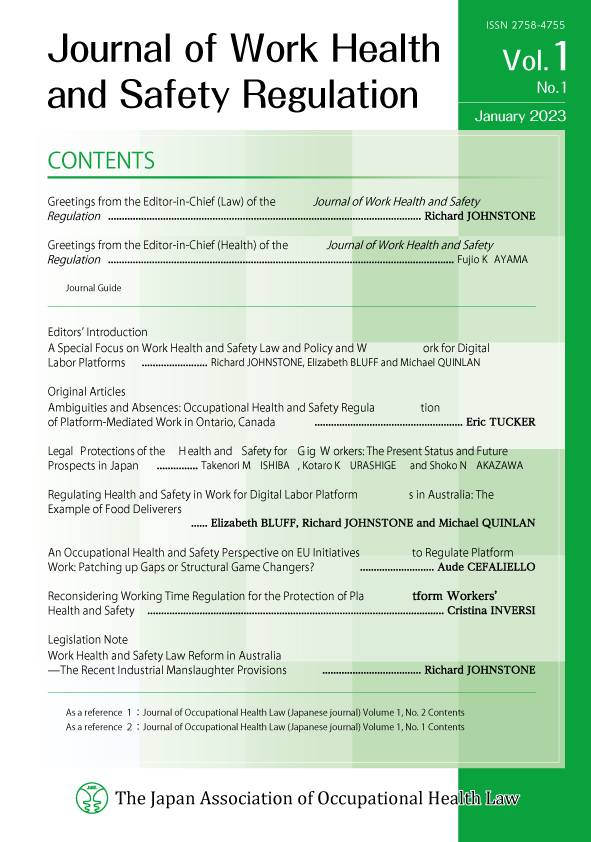Journal guide
Journal guide
JOWHSR can be seen at J-STAGE ![]()
https://www.jstage.jst.go.jp/browse/jaohlev/-char/en
SUBMITTING MANUSCRIPTS
The Journal of Work Health and Safety Regulation (J Work Health Saf Regul : JOWHSR) invites submissions in all fields related to the Work Health Health and Safety Regulation.
Please read the following guidelines and information before proceeding to the submission.
*We changed the name of the journal from “Journal of Occupational Health Law (JOHL)” to “Journal of Work Health and Safety Regulation (JOWHSR)“.
1. EDITORIAL BOARD AND COMMITTEE OF THE JOURNAL
1.1. Editorial Board
Vol.2 No.2-
Editors-in-Chief
Yasuo Suwa
(professor emeritus, Hosei University, Japan)
Fujio Kayama, Health
(professor emeritus, Jichi Medical University, Japan)
Deputy Editor-in-Chief
Tōru Yoshikawa, Health (senior researcher (deputy director), Research Center for Overwork-Related Disorders, National Institute of Occupational Safety and Health, Japan)
Editor
Diana Kloss MBE, Law
(professor, London South Bank University, UK)
Erica Martin, Law
(legal specialist, International Labour Organization, Canada)
Shinichi Ago, Law
(professor, emeritus Kyushu University, ILO Committee of Experts on the Application of Conventions and Recommendations, Japan)
Masaya Takahashi, Health and Policy
(director, Research Center for Overwork-Related Disorders, National Institute of Occupational Safety and Health, Japan)
Maria Karanika-Murray, Health
(professor, Leicester University, UK)
Lisa Rodgers, Law
(associate professor, Leicester University, UK)
Takenori Mishiba, Law
(professor, Kindai University Faculty of Law, Japan)
Administrator
Takenori Mishiba, Law
(professor, Kindai University Faculty of Law, Japan)
-Vol.2 No.1
Editors-in-Chief
Richard Johnstone, Law
(honorary professorial fellow, Melbourne Law School, The University of Melbourne, Australia)
Fujio Kayama, Health
(professor emeritus, Jichi Medical University, Japan)
Deputy Editor-in-Chief
Tōru Yoshikawa, Health (senior researcher (deputy director), Research Center for Overwork-Related Disorders, National Institute of Occupational Safety and Health, Japan)
Editor
Diana Kloss MBE, Law
(professor, London South Bank University, UK)
Administrator
Takenori Mishiba, Law
(professor, Kindai University Faculty of Law, Japan)
Advisor
Masaya Takahashi, Health
(director, Research Center for Overwork-Related Disorders, National Institute of Occupational Safety and Health, Japan)
1.2. Editorial Committee
Chairperson
Akizumi Tsutsumi (professor, Department of Public Health, Kitasato University School of Medicine, Japan)
Deputy Chairperson
Takenori Mishiba (professor, Kindai University Faculty of Law, Japan)
Chiefs
Noritada Katō (occupational (health) physician, Fuji Electric Co., Ltd., Japan)
Masaki Imura (professor, Otemon Gakuin University Faculty of Law, Japan)
Makoto Okawara (full-time lecturer, Department of Environmental Epidemiology, Institute of Industrial Ecological Sciences, University of Occupational and Environmental Health, Japan)
Members
Toshiya Irokawa (professor, Occupational Health, Tohoku University School of Medicine, Japan)
Teruhisa Uwatoko (professor, University Health Center, Kyoto University of Education, Japan)
Hisashi Eguchi (professor, Department of Mental Health, Institute of Industrial Ecological Sciences, University of Occupational and Environmental Health, Japan)
Tōru Yoshikawa (senior researcher (deputy director), Research Center for Overwork-Related Disorders, National Institute of Occupational Safety and Health, Japan)
Yūko Odagiri (lecturer, Public Health, Tokyo Medical University, Japan)
Fujio Kayama (emeritus professor, Jichi Medical University, Japan)
Shōgo Hino (professor, Shukutoku University School of Community Studies, Japan)
Tatsuya Sasaki (associate professor, Nagoya Gakuin University Faculty of Law, Japan)
Takayuki Hara (professor, Aomori Chuo Gakuin University Faculty of Law and Management, Japan)
Kōsuke Mafune (senior lecturer, Department of Mental Health, Institute of Industrial Ecological Sciences, University of Occupational and Environmental Health, Japan)
Hajime Yoshida (director, Tenma Law Office; former visiting professor, Kyoto University, Japan)
Toshihiro Okada (attorniey at law, Japan)
Keiichi Matsuzaki (senior lecturer, Department of Public Health, Kitasato University School of Medicine, Japan)
Yuta Morinaga (professor, Faculty of Economics Department of Management Studies, Sophia University, Japan)
Takehiko Yamada (council member, Occupational Health Promotion Foundation, Japan)
Advisor
Masaya Takahashi (director, Research Center for Overwork-Related Disorders, National Institute of Occupational Safety and Health, Japan)
Click here for the members of board of the Association.
2. JOURNAL POLICY
2.1. Aims and Scope
The Journal of Work Health and Safety Regulation (JOWHSR) is a peer-reviewed multidisciplinary journal of international scope in work health and safety regulation. It is published biannually in English and administered by the Japan Association of Occupational Health Law.
Before submitting your manuscript, please ensure you have read the aims and scope of the journal.
The aim of the journal is to advance academic research and to inform policy debate and decision-making in all aspects of work health and safety regulation, including prevention, compensation, and rehabilitation/return to work.
The Journal is interested in submissions that include analysis of legislative, administrative, or judicial developments in a single country that have transnational implications or that relate to potential international trends; doctrinal (legal analytical) comparisons addressing common work health and safety issues across two or more countries; empirical analyses; case studies; analysis of theoretical, methodological, or historical issues in work health and safety regulation; scholarship on mixed systems of law or of supranational legal regulation; and discussion of economic, social, or cultural aspects of work health and safety regulation and/or the ‘transferability’ of legal rules or policy approaches.
Multidisciplinary and interdisciplinary perspectives on work health and safety regulation – including from occupational health, medicine, sociology, regulatory studies, industrial relations, psychology, social policy, criminology, socio-legal studies, and history – are welcome.
The journal is also interested in submissions that analyze important court decisions (case notes), reports on work health and safety regulation issues (reports) and developments in work health and safety legislation (legislation notes), as well as reviews of books on work health and safety regulation (book reviews). The journal will also publish occasional editorials (including guest editorials) reporting on developments in work health and safety regulation from around the world.
2.2. Area of specialty
1) Basic framework of activities
The greatest characteristic of this association is the orientation towards problem-solving and prevention. Conventionally, laws have been oriented towards resolving disputes that have already occurred. By having its foundation based on the knowledge that is cultivated in such a manner, the Japan Association of Occupational Health Law (JAOHL) combines knowledge from various related fields and seeks to resolve and prevent legal
issues concerning work health and safety. We welcome everything from the latest academic research to practical debates concerning the challenges in the field. In our educational activities, we emphasize the practical legal education of occupational health professionals, such as industrial physicians (Fig. 1).
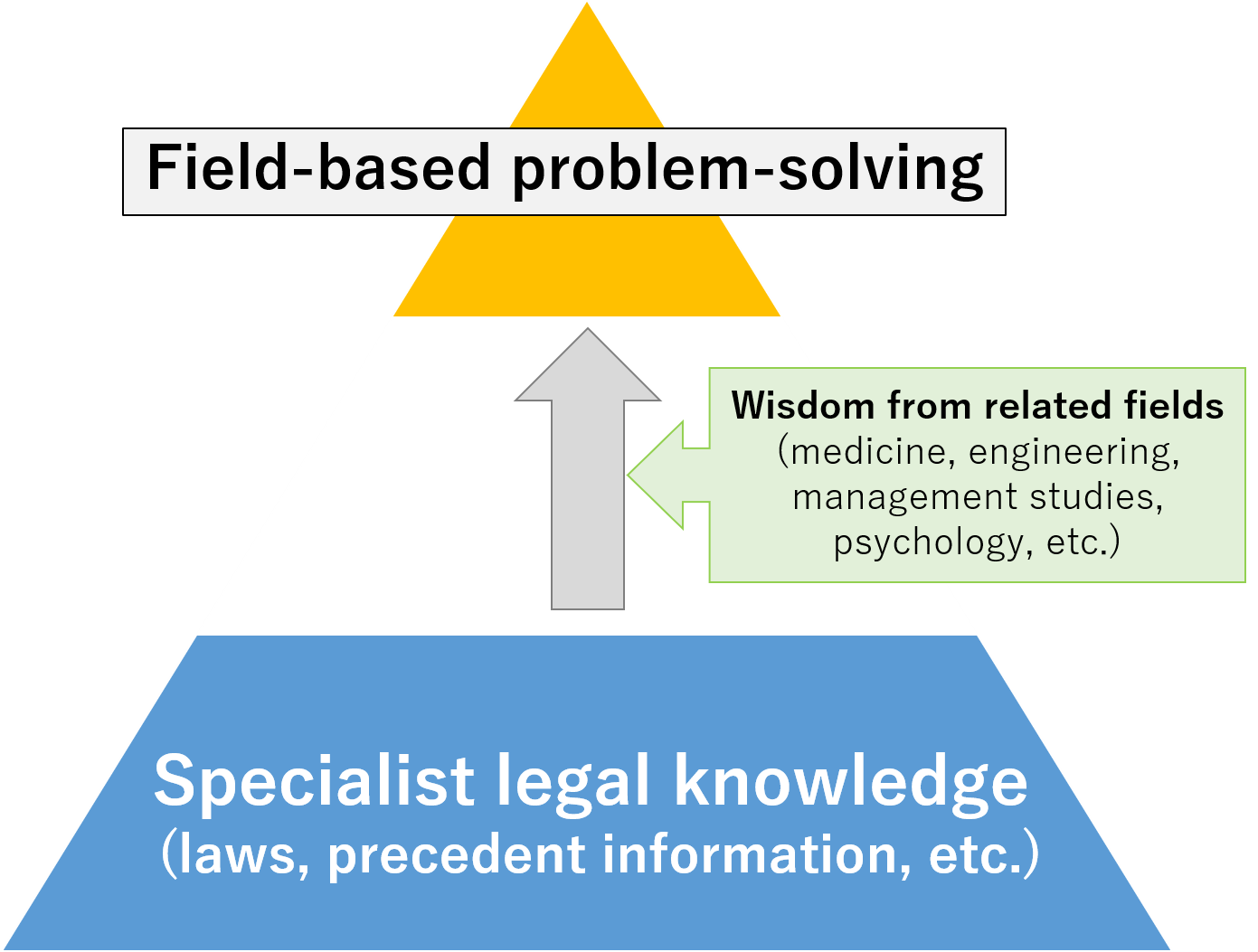
Fig. 1. Basic framework of JAOHL activities
2) Area of specialty toward “field-based problem-solving”
Our area of specialty is aimed toward field-based problem-solving, which can be organized as
shown in Fig. 2. While the horizontal axis represents time, the vertical axis represents perspective, creating the following four quadrants.
(1) Macro-level × prevention
How should legal systems be created to prevent work health and safety problems from occurring?
cf. proposals for work health and safety legislation, etc.
For example, how should the work health and safety of freelancers and teleworkers be regulated, and how should the handling of chemicals with unknown toxicity be regulated.
(2) Macro-level × ex post facto resolution
How should the legal systems and laws at the national level be created to resolve the work health and safety problem?
cf. how should the industrial accident compensation systems work, how should the industrial accident compensation be wound up, etc.
For example, how should the findings of industrial accidents be made for chemical hypersensitivity or hepatitis when the effects of overconsumption of alcohol during work are suspected, and how should the decision to discontinue industrial accident compensation be made in the case of mental disorders, which can last over long terms.
(3) Micro-level × prevention
How should the company rules and systems be created to prevent work health and safety problems from occurring?
cf. the state of company rules and systems that are useful for prevention, etc.
For example, if there are useful examples of decreases in the number of unwell people or trouble through the preparation of new health management regulations, there must be an analysis of their factors and whether they can be expanded.
(4) Micro-level × ex post facto resolution
In order to resolve the work health and safety problems after the fact, how should individual methods and laws be created when the parties go to court?
cf. know-how about out-of-court dispute resolution, theories of appropriate compensation, etc.
For example, if there are strategies that have contributed towards the prevention of disputes at an early stage, when employees suffer unclear health disorders outside work, there must be an analysis of their factors and whether they can be expanded.

Fig. 2. Organization of field-based problem-solving
The issues that this Association will tackle for the time being
(1) Legal system that encourages collaborative work health and safety by various stakeholders
(2) Diverse and dense work destinations, possible health problems and legal regulations
(3) Measures to ensure health and safety in response to the increase in double-employed and self-employed
(4) Future chemical substance management and the law
(5) Criteria for certifying workers’ injuries and healing of brain/heart diseases and mental disorders based on the evolution of diagnostics and pathology
(6) Scope of application of industrial accident compensation for health disorders other than brain heart disease and mental illness
(7) How to properly handle health information
(8) Appropriate return to work determination
(9) Appropriate way of dealing with employees who have problems with personality and development (including reasonable consideration) in the workplace
(10) Effective countermeasures against harassment
It applies an editorial policy that:
– is committed to a rigorous analysis;
– fosters diversity and equality of opportunity by strongly encouraging submissions in English or Japanese by authors of all generations and from all world regions;
– welcomes manuscripts related to the world of work health and safety regulation from all disciplines and encourages the submission of those with an inter-disciplinary approach;
– welcomes both theoretical and empirically-based studies, as well as comparative and international studies, and country-level studies that explore concepts, trends, and institutions that are of interest to an international audience;
– promotes a style of writing that is accessible to both academics, policy-makers, and a multidisciplinary readership.
Click here for its basic scope.
It applies an editorial policy that:
is committed to a rigorous analysis;
fosters diversity and equality of opportunity by strongly encouraging submissions in English or Japanese by authors of all generations and from all world regions;
welcomes manuscripts related to the world of work health and safety regulation from all disciplines and encourages the submission of those with an inter-disciplinary approach;
welcomes both theoretical and empirically-based studies, as well as comparative and international studies, and country-level studies that explore concepts, trends and institutions that are of interest to an international audience;
promotes a style of writing that is accessible to both academics and policy-makers and a multidisciplinary readership.
3. INSTRUCTIONS FOR AUTHORS
For further information, please click here.


